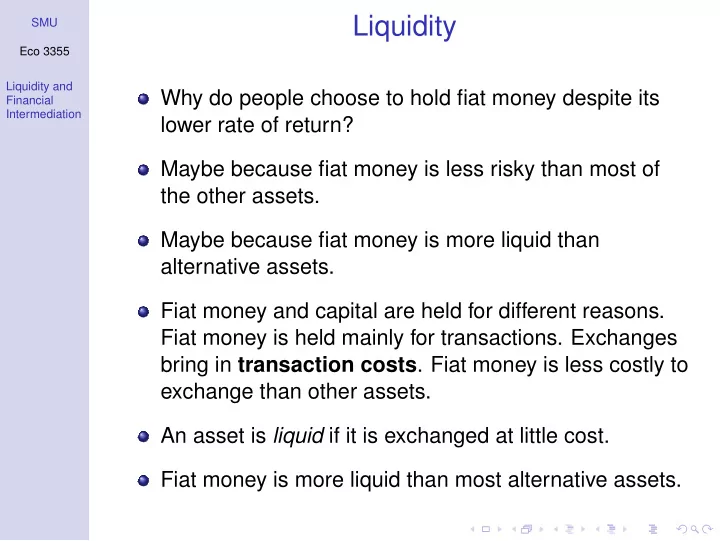

Liquidity SMU Eco 3355 Liquidity and Why do people choose to hold fiat money despite its Financial Intermediation lower rate of return? Maybe because fiat money is less risky than most of the other assets. Maybe because fiat money is more liquid than alternative assets. Fiat money and capital are held for different reasons. Fiat money is held mainly for transactions. Exchanges bring in transaction costs . Fiat money is less costly to exchange than other assets. An asset is liquid if it is exchanged at little cost. Fiat money is more liquid than most alternative assets.
A model of illiquidity SMU Eco 3355 Liquidity and Financial To capture the essential distinction between liquid and Intermediation illiquid assets consider an extension of the simple model where in addition: Fiat money and capital are both valued; The fiat money stock is constant; The rate of return on capital exceeds that of fiat money; Fiat money is exchanged more often than capital; People live for 3 periods and are only endowed with consumption good in the first period; A unit of capital returns X > n 2 two periods after its created.
A model of illiquidity SMU Eco 3355 Liquidity and Two informational assumptions: Financial Intermediation 1 It is impossible to observe the capital created by others; It is impossible to enforce repayment of IOUs (no 2 lending). An individual can use capital created to consume in the third period. Capital, however, does not produce in the second period and cannot be traded for consumption because it is not observed in the first period. Fiat money is used to buy second period consumption, but not third period consumption since the return on capital is higher.
A model of illiquidity SMU Eco 3355 The two period rate of return on money is less than that Liquidity and Financial of capital: Intermediation v t + 2 = v t + 2 v t + 1 = nn = n 2 < X v t v t + 1 v t Summarizing, the period budget constraints are: c 1 , t + v t m t + k t ≤ y , c 2 , t + 1 ≤ v t + 1 m t , c 3 , t + 2 ≤ Xk t . The lifetime budget constraint is: � v t � 1 � � c 1 , t + c 2 , t + 1 + c 3 , t + 2 ≤ y . v t + 1 X
A model of illiquidity SMU Eco 3355 Liquidity and Financial It seems that the rate-of-return equality is violated in Intermediation this model: The one-period rate of return on fiat money is higher than that of capital; The two-period rate of return on capital is higher than that of fiat money. That is because the two assets are not perfect substitutes. (e.g. agents cannot trade capital in their second period of life). Note that the rate-of-return equality principle still applies to each period considered separately.
The Business of Banking SMU Eco 3355 Liquidity and Financial Intermediation Suppose some people cannot hide from their creditors so that enforcement of their IOUs is possible. Use ability to borrow to profit from difference between the rates of return on long and short term assets – this is called arbitrage . Borrow one good in period t from a young person and invest in capital. You need to pay her at least n in period t + 1 for her to be willing to lend. In period t + 1 borrow n units from a young person and pay the initial lender.
Arbitrage in equilibrium SMU Eco 3355 Liquidity and In period t + 2 receive X from your investment in capital Financial Intermediation and pay n to your second lender. You profited X − n 2 . This financial intermediation is what banks do: the loans you get are the deposits and your investment is the loan you (as a bank) make. The mismatch between the liquid money and the illiquid capital are corrected by the arbitrage. The IOUs (deposits) are called inside money . What happens if a large number of people can issue IOUs? Profits go to zero. What will be the one-period rate of return ( r ∗ ) paid on √ these IOUs? The rate that makes profits zero: r ∗ = X .
Example SMU Eco 3355 Liquidity and Financial Intermediation Suppose the two period rate of return on capital is X = 1 . 21, population growth rate is n = 1 . 05. Intermediaries agree to pay a one period rate-of-return on deposits of r = 1 . 05. a Calculate the intermediary’s profit. b If there are a large number of intermediaries what will be the equilibrium rate-of-return on deposits? c How does intermediation affect capital and output in the economy?
Recommend
More recommend